

Fear of nuclear annihilation scarred children growing up in the Cold War, studies later showed. For David Ropeik and many others, the Cuban Missile Crisis was that moment, the point of no return, a feeling of teetering on death.
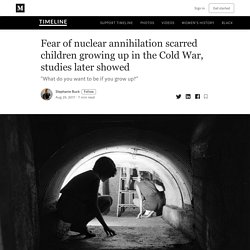
One of the biggest cultural oversights at the time, however, was the notion that children couldn’t grasp the seriousness of the world stage. On the contrary, many of them grasped it all too well. President Kennedy had the proof in his mailbox. One child wrote in 1961, “I am 9 years old. I don’t like the plans you are planning.
At home, children anxiously settled into their new fear-based realities. Older children, or those who aged into teenagers during the Cold War, tended to have a more resigned outlook. Others derived opportunistic humor. A common joke during these years was “What do you want to be if you grow up?” In 1945, Americans were thrilled with nuclear weapons. That’s no longer true. In 1945, Americans were thrilled with nuclear weapons. That’s no longer true. Atomic Scare Film - "One World Or None" - 1946. Short Vision, A (1956)
A Short Vision became one of the most influential British animated films ever made when it was screened on US television as part of the popular Ed Sullivan Show.
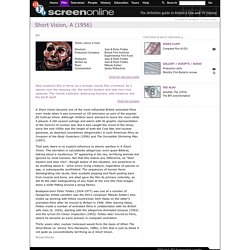
Although children were advised to leave the room while it played, it still caused outrage and alarm with its graphic representation of the horrors of nuclear war. Duck And Cover (1951) Bert The Turtle. Department of History. Jennifer M.
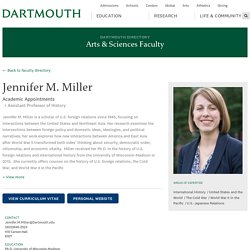
Miller is a scholar of U.S. foreign relations since 1945, focusing on interactions between the United States and Northeast Asia. Her research examines the intersections between foreign policy and domestic ideas, ideologies, and political narratives; her work explores how new interactions between America and East Asia after World War II transformed both sides’ thinking about security, democratic order, citizenship, and economic vitality.
Miller received her Ph.D. in the history of U.S. foreign relations and international history from the University of Wisconsin-Madison in 2012. Commander USA Groovy Movies - Beginning of the End. U.S. film tells story of Japanese boat exposed to 1954 nuclear test. BFI National Archive. Target Nevada (film) 1951 instructional documentary film by the United Stares Air Force Target Nevada established that throughout the early history and development of nuclear weapons, scientists at Los Alamos National Laboratory began nuclear weapons testing.
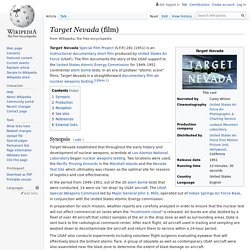
Two locations were used, the Pacific Proving Grounds in the Marshall Islands and the Nevada Test Site which ultimately was chosen as the optimal site for reasons of logistics and cost effectiveness. In the period from 1949–1951, out of the 20 atom bomb tests that were conducted, 14 were via "air drop" by USAF aircraft. The USAF Special Weapons Command led by Major General John S. Mills, operated out of Indian Springs Air Force Base, in conjunction with the United States Atomic Energy commission.
In preparation for each mission, weather reports are carefully analyzed in order to ensure that the nuclear test will not affect commercial air lanes when the "mushroom cloud" is released. "Buster-Jangle Dog", c. 1951 Bogle, Lori Lynn. Target Nevada at YouTube. Duck and Cover (film) The film was funded by the US Federal Civil Defense Administration and released in January 1952.
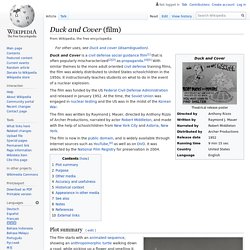
At the time, the Soviet Union was engaged in nuclear testing and the US was in the midst of the Korean War. The film starts with an animated sequence, showing an anthropomorphic turtle walking down a road, while picking up a flower and smelling it. A chorus sings the Duck and Cover theme: There was a turtle by the name of Bert and Bert the turtle was very alert; when danger threatened him he never got hurt he knew just what to do ... He'd duck! One World or None. 1946 film One World or None (1946) is an instructional documentary short film produced by the National Committee on Atomic Information in conjunction with Philip Ragan Productions.
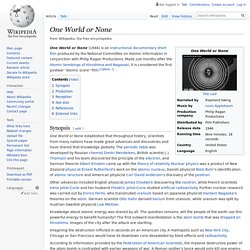
Made just months after the Atomic bombings of Hiroshima and Nagasaki, it is considered the first postwar "atomic scare" film.[1][Note 1] Synopsis[edit] One World or None established that throughout history, scientists from many nations have made great advances and discoveries and have shared that knowledge globally. The periodic table was developed by Russian chemist Dmitri Mendeleev, British scientist J. Other advances included English physicist James Chadwick discovering the neutron, while French scientists Irène Joliot-Curie and her husband Frédéric Joliot-Curie studied artificial radioactivity.
Knowledge about atomic energy was shared by all. Atomic Power (film) 1946 film Atomic Power on IMDb.

Children of the Atomic Bomb: An American Physician’s Memoir of Nagasaki, Hiroshima, and the Marshall Islands (Asia-Pacific: Culture, Politics, and Society) (9780822316589): Yamazaki, James N., Fleming, Louis B.: Books. The Radiation Reality of Superheroes. Superman's Uncomfortable History with Nuclear Weapons...